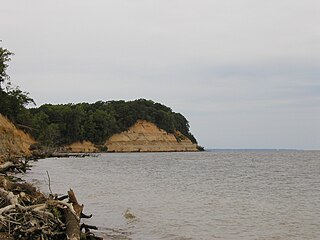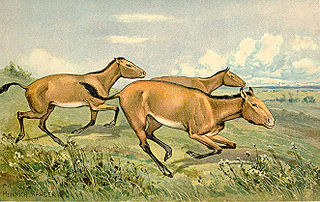External links
- ↑ "ICS Timescale Chart" (PDF). www.stratigraphy.org.
| System/ Period | Series/ Epoch | Stage/ Age | Age (Ma) | |
|---|---|---|---|---|
| Quaternary | Pleistocene | Gelasian | younger | |
| Neogene | Pliocene | Piacenzian | 2.58 | 3.600 |
| Zanclean | 3.600 | 5.333 | ||
| Miocene | Messinian | 5.333 | 7.246 | |
| Tortonian | 7.246 | 11.63 | ||
| Serravallian | 11.63 | 13.82 | ||
| Langhian | 13.82 | 15.97 | ||
| Burdigalian | 15.97 | 20.44 | ||
| Aquitanian | 20.44 | 23.03 | ||
| Paleogene | Oligocene | Chattian | older | |
| Subdivision of the Neogene Period according to the ICS, as of 2017. [1] | ||||
The Middle Miocene is a sub-epoch of the Miocene Epoch made up of two stages: the Langhian and Serravallian stages. The Middle Miocene is preceded by the Early Miocene.
The sub-epoch lasted from 15.97 ± 0.05 Ma to 11.608 ± 0.005 Ma (million years ago). During this period, a sharp drop in global temperatures took place. This event is known as the Middle Miocene Climate Transition.
For the purpose of establishing European Land Mammal Ages this sub-epoch is equivalent to the Astaracian age.

The geologic time scale (GTS) is a system of chronological dating that classifies geological strata (stratigraphy) in time. It is used by geologists, paleontologists, and other Earth scientists to describe the timing and relationships of events in geologic history. The time scale was developed through the study and observation of layers of rock and relationships as well as the times when different organisms appeared, evolved and became extinct through the study of fossilized remains and imprints. The table of geologic time spans, presented here, agrees with the nomenclature, dates and standard color codes set forth by the International Commission on Stratigraphy (ICS).
The Miocene is the first geological epoch of the Neogene Period and extends from about 23.03 to 5.333 million years ago (Ma). The Miocene was named by Scottish geologist Charles Lyell; its name comes from the Greek words μείων and καινός and means "less recent" because it has 18% fewer modern sea invertebrates than the Pliocene. The Miocene is preceded by the Oligocene and is followed by the Pliocene.
The Neogene is a geologic period and system that spans 20.45 million years from the end of the Paleogene Period 23.03 million years ago (Mya) to the beginning of the present Quaternary Period 2.58 Mya. The Neogene is sub-divided into two epochs, the earlier Miocene and the later Pliocene. Some geologists assert that the Neogene cannot be clearly delineated from the modern geological period, the Quaternary. The term "Neogene" was coined in 1853 by the Austrian palaeontologist Moritz Hörnes (1815–1868).
The Pliocene Epoch is the epoch in the geologic timescale that extends from 5.333 million to 2.58 million years BP. It is the second and most recent epoch of the Neogene Period in the Cenozoic Era. The Pliocene follows the Miocene Epoch and is followed by the Pleistocene Epoch. Prior to the 2009 revision of the geologic time scale, which placed the four most recent major glaciations entirely within the Pleistocene, the Pliocene also included the Gelasian stage, which lasted from 2.588 to 1.806 million years ago, and is now included in the Pleistocene.

Calvert Cliffs State Park is a public recreation area in Lusby, Calvert County, Maryland, that protects a portion of cliffs that extend for 24 miles along the eastern flank of the Calvert Peninsula on the west side of Chesapeake Bay from Chesapeake Beach southward to Drum Point. The state park is known for the abundance of mainly Middle Miocene sub-epoch fossils that can be found on the shoreline.

The Zanclean is the lowest stage or earliest age on the geologic time scale of the Pliocene. It spans the time between 5.332 ± 0.005 Ma and 3.6 ± 0.005 Ma. It is preceded by the Messinian age of the Miocene epoch, and followed by the Piacenzian age.
The Chibanian, widely known by its previous designation of Middle Pleistocene, is an age in the international geologic timescale or a stage in chronostratigraphy, being a division of the Pleistocene epoch within the ongoing Quaternary period. The Chibanian name was officially ratified in January 2020. It is currently estimated to span the time between 0.770 Ma and 0.126 Ma, also expressed as 770–126 ka. It includes the transition in palaeoanthropology from the Lower to the Middle Palaeolithic over 300 ka.
The Serravallian is, in the geologic timescale, an age or a stage in the middle Miocene epoch/series, which spans the time between 13.82 Ma and 11.63 Ma. The Serravallian follows the Langhian and is followed by the Tortonian.
The Langhian is, in the ICS geologic timescale, an age or stage in the middle Miocene epoch/series. It spans the time between 15.97 ± 0.05 Ma and 13.65 ± 0.05 Ma during the Middle Miocene.
The Tortonian is in the geologic time scale an age or stage of the late Miocene that spans the time between 11.608 ± 0.005 Ma and 7.246 ± 0.005 Ma. It follows the Serravallian and is followed by the Messinian.
The Chattian is, in the geologic timescale, the younger of two ages or upper of two stages of the Oligocene epoch/series. It spans the time between 28.1 and23.03 Ma. The Chattian is preceded by the Rupelian and is followed by the Aquitanian.

In the geologic timescale, the Middle Triassic is the second of three epochs of the Triassic period or the middle of three series in which the Triassic system is divided in chronostratigraphy. The Middle Triassic spans the time between 247.2 Ma and 237 Ma. It is preceded by the Early Triassic epoch and followed by the Late Triassic epoch. The Middle Triassic is divided into the Anisian and Ladinian ages or stages.

Aelurodon is an extinct canine genus of the subfamily Borophaginae which lived from the Barstovian land mammal age of the middle Miocene to the late Miocene epoch. Aelurodon existed for approximately 10.7 million years.
The Late Miocene is a sub-epoch of the Miocene Epoch made up of two stages. The Tortonian and Messinian stages comprise the Late Miocene sub-epoch, which lasted from 11.63 Ma to 5.333 Ma.
The Early Miocene is a sub-epoch of the Miocene Epoch made up of two stages: the Aquitanian and Burdigalian stages.

The Barstovian North American Stage on the geologic timescale is the North American faunal stage according to the North American Land Mammal Ages chronology (NALMA), typically set from 16,300,000 to 13,600,000 years BP, a period of 2.7 million years. It is usually considered to overlap the Langhian and Serravallian stages of the Middle Miocene. The Barstovian is preceded by the Hemingfordian and followed by the Clarendonian NALMA stages.

The Vallesian age is a period of geologic time within the Miocene used more specifically with European Land Mammal Ages. It precedes the Turolian age and follows the Astaracian age. The so-called Vallesian Crisis resulted in the extinction of several mammalian taxa characteristic of the Middle Miocene.
The Montehermosan age is a period of geologic time within the Miocene and Pliocene epochs of the Neogene used more specifically with South American Land Mammal Ages. It follows the Huayquerian and precedes the Chapadmalalan age.
The Early Pleistocene is an unofficial sub-epoch in the international geologic timescale in chronostratigraphy, being the earliest division of the Pleistocene Epoch within the ongoing Quaternary Period. It is currently estimated to span the time between 2.580 ± 0.005 Ma and 0.773 ± 0.005 Ma. The term Early Pleistocene applies to both the Gelasian Age and the Calabrian Age.

The Chipola Formation is a Late Oligocene to Early Miocene geologic formation in the Florida Panhandle and member of the Alum Bluff Group.